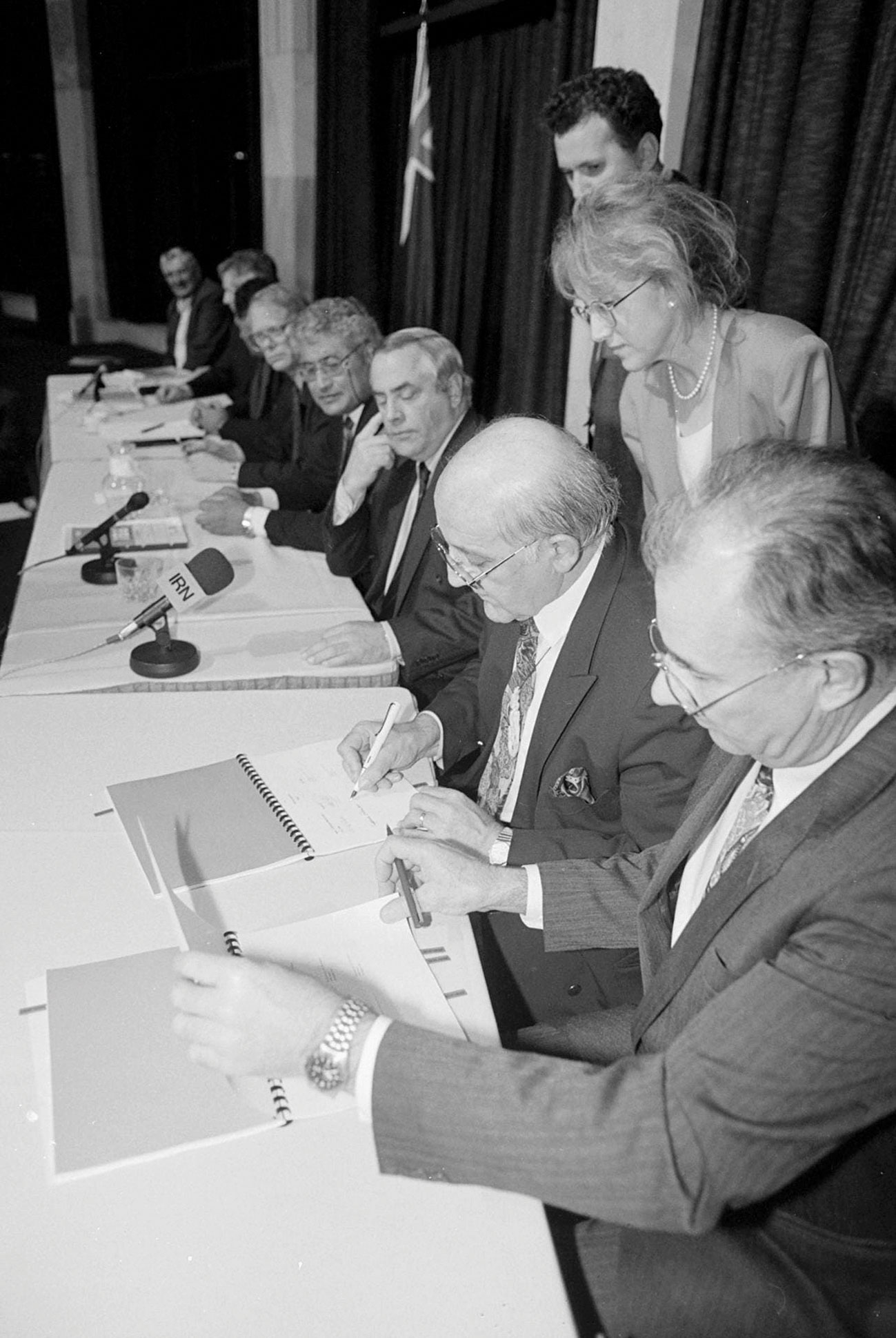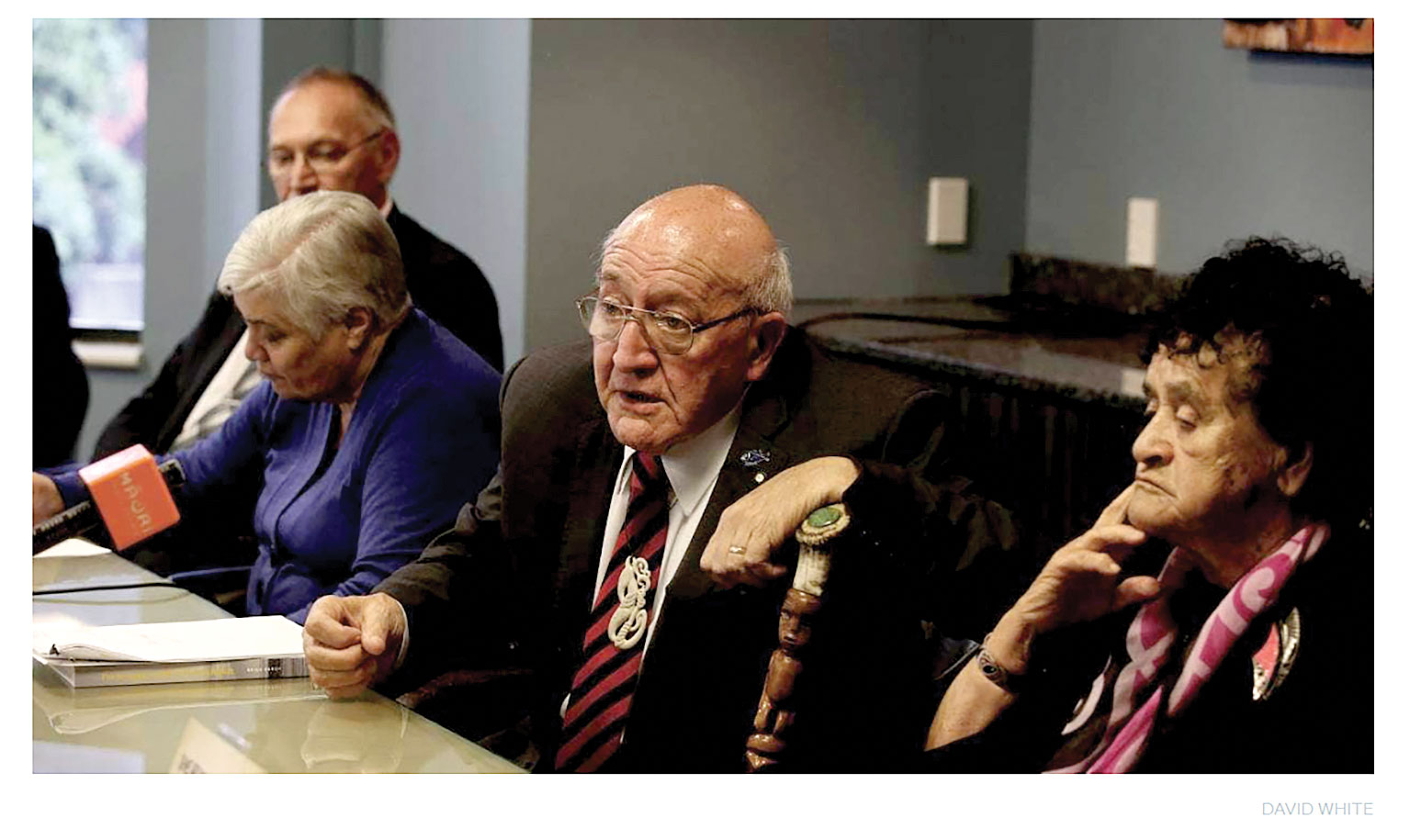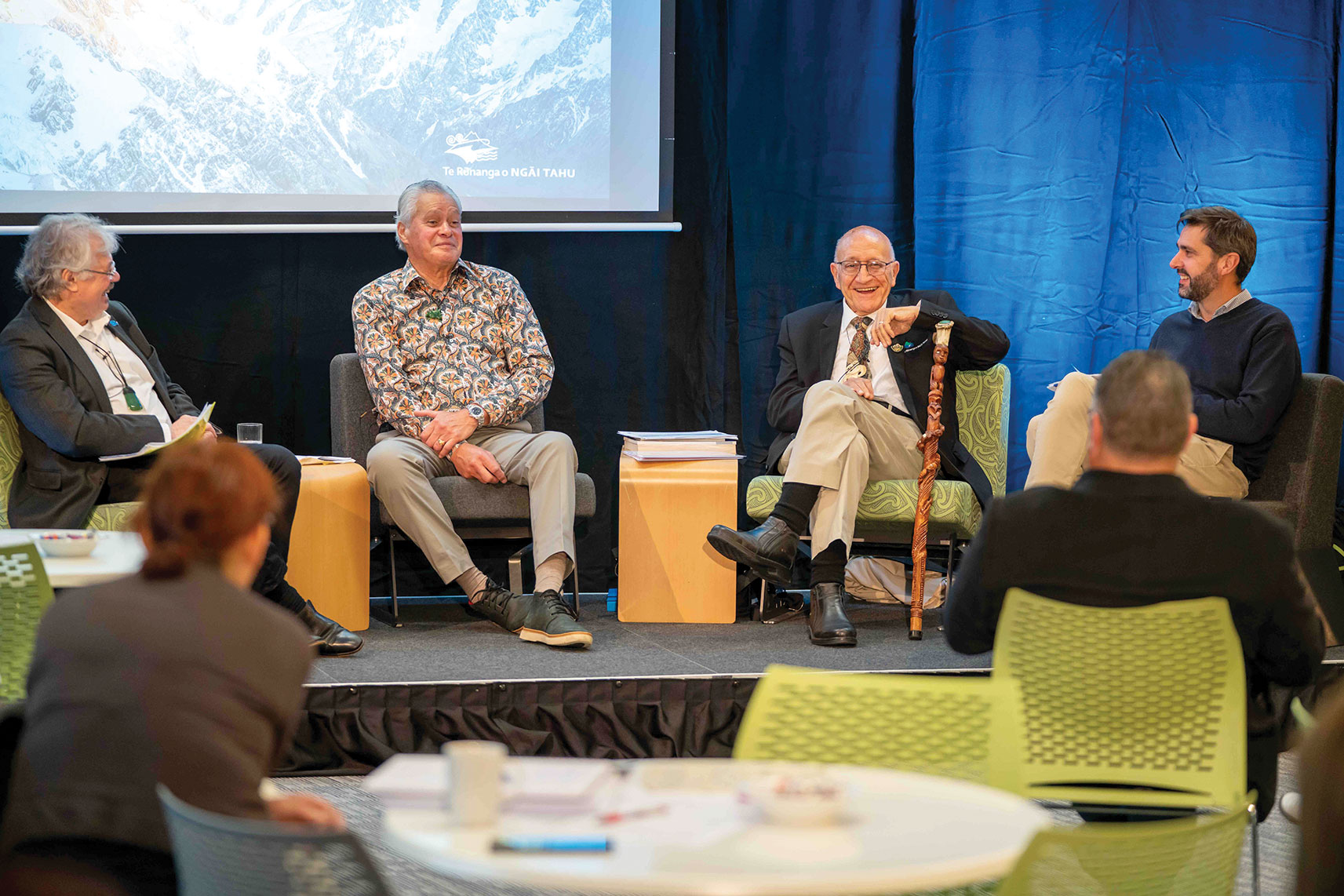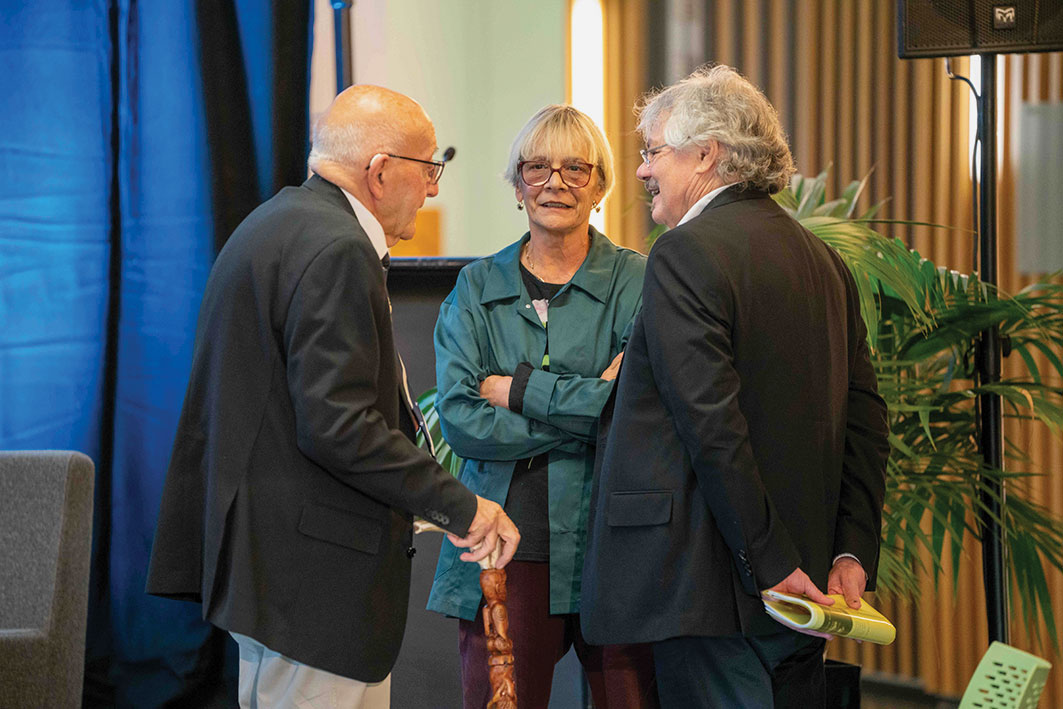A take without end
Jul 12, 2023

Nā Justine Inns
23 September is a pretty significant date on the Ngāi Tahu calendar. A small number of us recall it was on 23 September 1997 that Crown and Ngāi Tahu negotiators, led by Tā Tipene O’Regan, initialled the Ngāi Tahu Deed of Settlement, approving it as the final form of the Settlement, which would be recommended to Ngāi Tahu Whānui for ratification.

Government Ministers and Māori Negotiators sign the 1992 Deed of Settlement. Photograph Fairfax Media.
The Settlement would go on to be ratified by well in excess of 90 percent of those who participated in the vote and to be formally signed, with great fanfare and emotion, at Takahanga Marae on 21 November of the same year. Many more will be aware that the Māori Fisheries Settlement was signed by Crown and Māori negotiators, including Tā Tipene, on 23 September 1992. 23 September 1992 was also Tā Tipene’s 53rd birthday.
When the 30th anniversary of the Fisheries Settlement signing was celebrated at Parliament last September, Tā Tipene was unfortunately absent due to his attendance at the funeral of the Queen as part of the Aotearoa/New Zealand contingent.
So, 30 years on, what is the legacy of the Fisheries Settlement?
First, a bit of history: after many years of litigation in the courts and the Waitangi Tribunal – in which Ngāi Tahu took a lead role, including through the landmark recognition of Māori fishing rights in the 1986 case of Te Weehi v Regional Fisheries Officer – an interim settlement with respect to those rights was reached in 1989. The interim settlement allowed implementation of the Quota Management System (QMS) to proceed, with the creation of the Māori Fisheries Commission, which received 10 percent of quota for all fish species then in the QMS to hold and manage on behalf of Māori.
This was built on by the 1992 Fisheries Settlement, under which the Crown reconstituted the Māori Fisheries Commission as the Treaty of Waitangi Fisheries Commission, funded the purchase of a 50 percent stake in the Sealord Group, committed to provide Māori with 20 percent of quota for all new species entering the QMS, and undertook to make regulations to empower self-management of non-commercial customary fishing.

Iwi leaders come together to argue the case for iwi fishing rights in the Kermadecs 2016. Photograph David White for Stuff.
Such regulations would not materialise until 1998 and – for Te Wai Pounamu – would require the additional nudge of a second Crown commitment to promulgate them as part of the Ngāi Tahu Settlement.
Importantly, the commission, chaired by Tā Tipene, was charged with developing, in consultation with Māori, a scheme for the allocation and distribution of its assets to iwi. My involvement with the Fisheries Settlement began some time after Ngāi Tahu celebrated the passage of the Ngāi Tahu Claims Settlement Act in September 1998 (not on 23 September that year, but just a few days later on the 29th). I had supported the Ngāi Tahu negotiators on the Mahinga Kai chapter of the Settlement, which included several opportunities for greater iwi involvement in the management of natural resources, through the Resource Management Act 1991 (RMA), Conservation Act 1986 and the Fisheries Act 1996.
With the Ngāi Tahu Settlement moving into implementation phase, Te Rūnanga o Ngāi Tahu turned its attention back to the Fisheries Settlement. While the value of Fisheries Settlement assets had continued to increase over those years, the commission was thwarted in the job of devising an allocation scheme by deeply entrenched and apparently irreconcilable positions held by iwi. Ngāi Tahu and other iwi, including Ngāti Kahungunu, Ngāi Tamanuhiri and the Hauraki Iwi –in a grouping that came to be known as the Treaty Tribes Coalition – maintained that fisheries assets belong to those iwi off whose coasts they are caught: mana whenua, mana moana.
Other iwi, most prominently Ngāpuhi, argued that traditional dependence on fishing, and thus iwi population, should drive allocation of the assets.
To further complicate things, organisations serving urban Māori joined the fray to argue that those in the cities should be able to share in the benefits of settlement, independent of the iwi or hapū they had whakapapa to. In the late 1990s and early 2000s, I worked with the Treaty Tribes Coalition and supported Ngāi Tahu representatives (initially Charles Crofts, David Higgins and, later, Maria Pera) in efforts to see a resolution of the allocation debate. The 12 years from 1992 to 2004 saw innumerable (sometimes interminable) hui, many consultation rounds by the commission and several waves of litigation. Sitting in the back of the Privy Council Chambers at No.9 Downing Street in London, watching English Law Lords deliberate on the question of “what is an iwi?” must go down as one of my most surreal experiences.
The fight was ugly. Old enmities between some iwi were given a new lease of life and new ones began. Insults and even threats to iwi leaders became personal and nasty. The mistrust and suspicions of those days taint some relationships still.

Craig Ellison, David Higgins, Tā Tipene O’Regan and Dr Michael Stevens at the Fisheries Settlement wananga held earlier this year. Photograph Sampson Karst.
For better or worse, the matter was resolved by the Māori Fisheries Act 2004. The commission became Te Ohu Kaimoana and was directed to allocate inshore quota to iwi on the basis of their coastlines (necessitating iwi agreement on their coastal boundaries and deepwater quota predominantly (75 percent) on the basis of iwi population. Voting/control shares in Aotearoa Fisheries Ltd (trading now as Moana New Zealand), which holds the 50 percent interest in Sealord and other assets, would be retained by Te Ohu Kaimoana with only shares in any dividends from those companies allocated between iwi on the basis of their population.
And so the second phase of the Fisheries Settlement began, with iwi progressively acquiring control over fishing quota and receiving income from Moana and Sealord, but in a largely passive role. Also in 2004, the Māori Fisheries Settlement acquired a teina, with the passage of the Māori Commercial Aquaculture Claims Settlement Act creating an entitlement for iwi to receive assets equivalent to 20 percent of all waterspace licenses or consents for marine farming issued after 21 September 1992. The Aquaculture Settlement was described by ministers at the time as the “unfinished business” of the Fisheries Settlement – a surprising description given that Māori fisheries negotiators claimed that marine farming had never been discussed in their negotiations. A cynic might suggest that the aquaculture settlement had more to do with an attempt to soften the blow of the infamous Foreshore and Seabed Act passed the same month.
Nonetheless, the Aquaculture Settlement has delivered significant benefits to iwi, particularly in the traditional marine farming regions of Marlborough and the Hauraki Gulf. It was in this phase that we began to realise that “protecting the Settlement is a take without end” (with thanks to Dr Michael Stevens, who made this observation at a fisheries wānanga held recently at Te Whare o Te Wai Pounamu). Every marine reserve established around the coastline nibbles away at the ability to catch settlement quota and to exercise customary non-commercial rights. Every push back to the implementation of customary management tools, such as mātaitai (see the article on a recent court case over freshwater mātaitai in Kaikōura elsewhere in this issue) necessitates another rolling up of the sleeves and rolling into battle.
Increasingly, regional councils are looking to impose restrictions on some fishing through their plans made under the Resource Management Act. Confusingly, the RMA gives them the power to do so as long as it is not for the purpose of managing fishing or fisheries resources, as that is the purview of the Fisheries Act; but for another purpose, such as maintaining indigenous biological diversity. Unsurprisingly, negative effects on commercial and non-commercial fishers and on the value of settlement quota are not high on the priorities of most regional councils.
Larger threats are on the horizon. When the government announced its intention to establish the Rangitāhua/Kermadec Ocean Sanctuary in 2016, Ngāi Tahu joined with Te Ohu Kaimoana and other iwi to oppose the proposal, which would have effectively negated the value of settlement quota caught in the 620,000 square kilometres of the sanctuary. While the Kermadecs are about as far from the Ngāi Tahu takiwā as it is possible to get without leaving Aotearoa, the principle that the integrity of the Fisheries Settlement must be protected was brought to the fore. When a new iteration of the proposal was presented to iwi in early June this year, it was strongly rejected by them. Instead, iwi called for an indigenous-led approach to future marine management arrangements for that area. Whether that call will be heeded remains to be seen.
It used to be said that the QMS is one of the most successful fisheries management regimes in the world, and some of us still believe it holds that promise, though implementation has not always been perfect. Nowadays, it is more common to hear the QMS criticised for a range of reasons and there are calls for it to be scrapped and replaced. When you hear such calls, remember that the Fisheries Settlement and the QMS are effectively “joined at the hip”. Preserving the integrity of the Settlement in a transition to some fundamentally new fisheries management regime may be one of the challenges of the next decade.

Tā Tipene O’Regan, Gail Thompson and Craig Ellison. Photograph Sampson Karst.
Finally, as I write, the Fisheries Settlement is about to enter it third phase. The Māori Fisheries Amendment Bill currently before Parliament would change the governance arrangements of Te Ohu Kaimoana to give iwi more direct control over its composition and future direction. Full shareholdings in Moana New Zealand (and through it, Sealord Group) will also transfer to iwi. These developments follow a review of the current structures undertaken in 2015 – given the history of the Settlement, it seems sadly appropriate that this latest development should have such a long gestation.
To end on an optimistic note: there can be no question that the Fisheries Settlement has delivered. Iwi are said to control around 40 percent of the fishing industry – an industry responsible for annual exports worth $1.5 billion. Around 21 percent of those employed in the sector are said to identify as Māori, and that representation is increasingly seen in the boardroom – not just on the factory floor – through Moana and Sealord Group, at least.
Closer to home, Ngāi Tahu Seafood Limited has been an essential part of the tribe’s commercial endeavours for many years, and Ngāi Tahu Holdings Group is now the largest single shareholder in the Sanford Group Limited, which (along with Sealord and the Talleys Group) is one of New Zealand’s three corporate fishing giants. More than 700 appointed tāngata tiaki/kaitiaki manage customary non-commercial fisheries nationwide, and Ngāi Tahu has been more successful than most iwi in implementing this framework, with more than 150 tāngata tiaki/kaitiaki in place over 99.9 percent of the Ngāi Tahu Claims Area, a network of 35 mātaitai (many with bylaws) and four taiāpure across the takiwā.
So the Fisheries Settlement’s first 30 years can be described as slow and sometimes painful progress, but progress nonetheless. Will the next 30 years hold more of the same?